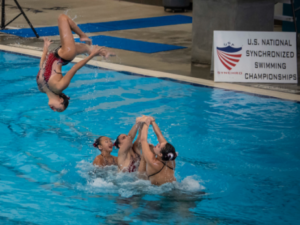Swimming to success
June 1, 2018
Her legs burn, exhausted. Her lungs crave oxygen. She strains to keep the beat for her teammates’ sake. Her whole body aches, screaming for rest. If she takes even a fraction of a second to pause, she will ruin the entire performance.
This experience is reality for Alexandra Suarez ‘18, a Cathedral Catholic High School student and national-caliber synchronized swimmer, who gracefully glides through the pool sporting a flashy swimsuit, bright and extravagant makeup, and bright smile, convincing onlookers she feels no pain, entrancing them with a seemingly effortless performance.
“Above the surface you have to perform and appear calm and energetic, but below the surface you are kicking, feeling fatigue, and thinking about the choreography,” Suarez said. “It’s pretty difficult to make things look easy when you are tired and out of oxygen, but we work hard at practice to push through it.”
Performing high level synchronized swimming certainly is difficult. Average routines, around three minutes long, require athletes to exhibit incredible strength, endurance, flexibility, and breath control.
Swim England, the national governing body for swimming in England, compares synchronized swimming to “running for up to five minutes while performing acrobatics, holding your breath, looking graceful, and having to keep in time to music.”
Suarez, having competed in the sport since she was 10 years old, has train with the U.S. Senior National Team, and she currently trains with the Santa Clara Aquamaids, a San Francisco Bay Area synchronized swimming organization established in 1964.
This year, the Aquamaids won gold in the team and duet events during the West Zones Championships, qualifying the squad for the U.S. Senior National Championships, where it won gold in the combination and technical team events and silver in the free team event.
In addition to her team’s success, Suarez recently committed to Stanford University to continue her education and further pursue synchronized swimming.
“I started talking to coaches my junior year, and at the beginning of my senior year, I got to go visit schools and teams,” Suarez said. “I picked Stanford because of its strong academic programs, and I was excited to be able to stay in California.”
Despite Stanford’s acceptance rate dropping to 4.29 percent with a mere 2,040 students of 47,450 applicants accepted for the Fall 2018 semester, the university’s lowest rate in history according to CBS, Suarez claimed her spot through hard work in both the classroom and the pool.
“I’ve always tried to push myself in school by taking as many hard classes as I can with my swim schedule,” Suarez said. “I prioritize my grades, and I always make time to study.”
Since starting synchronized swimming at a neighbor’s behest in 2010, Suarez has come to love the sport, especially the bond built with her teammates, Suarez said.
However, there are aspects of the sport she dislikes, such as the misunderstanding and ignorance most people have in regard to synchronized swimming.
“I dislike the fact that most people don’t know much about the sport, and there are a lot of common misconceptions,” Suarez said. “I’d say the main thing that most people don’t know is that we don’t stand on the bottom of the pool. Touching the bottom of the pool will get you disqualified.”
Typical practices run 4-10 hours a day, depending the day of the week, Suarez said. Usually starting with warm-up laps, the team then swims through its routines to prepare for competition.
Team and duet events, the only two synchronized swimming events played in the Olympics, each include a free routine and a technical routine. Other competitions, such as World Championships, include solo, duet, team, and combination events.
Technical routines are predetermined and performed strictly according to certain elements, while in free routines, swimmers create their own unique performance where they are required to show their creativity in choreography, dancing, and coordination.
Suarez’s family serves as a constant influence in her life through its constant support, motivating her drive to continue her swimming career into college.
“My family has always supported my decisions that I’ve made in my training, especially my decision to go to Northern California for most of my training,” Suarez said. “I am very excited to swim at the collegiate level, although I’m not really sure what I would like to do beyond the next four years.”
Suarez looks forward to her years swimming and studying at Stanford, where she hopes to improve both athletically and academically for her upcoming four years spent in Northern California.
“I think [synchronized swimming] is unique because it’s a performance sport that requires a lot of endurance,” Suarez said. “You also have to smile through the pain and make it look easy.”






















































